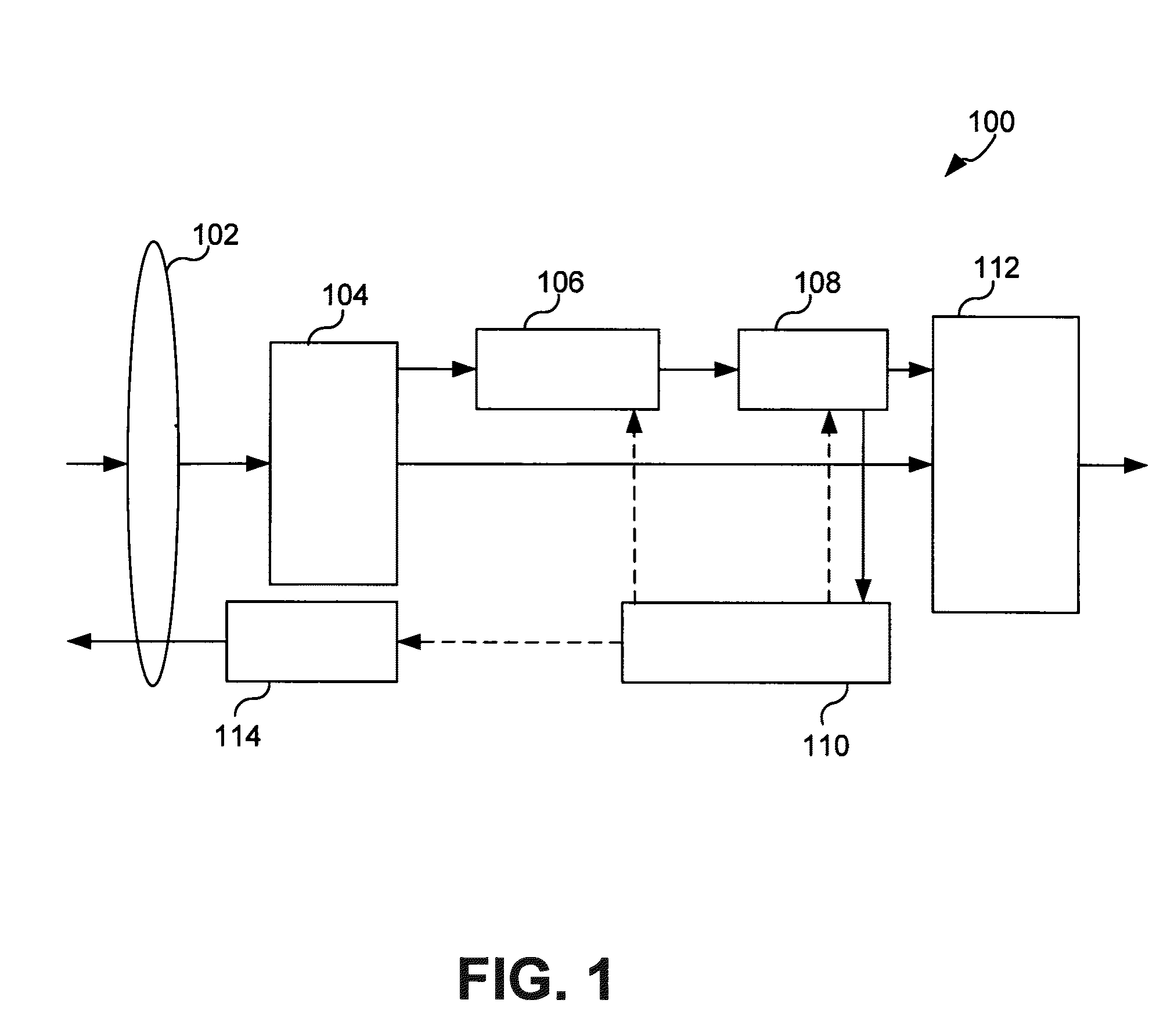Resolution on demand
a technology of image resolution and demand, applied in the field of image resolution on demand, can solve the problems of high-resolution imagery, high cost of resolution or dangerous collection, and images collected in the pan waveband
- Summary
- Abstract
- Description
- Claims
- Application Information
AI Technical Summary
Benefits of technology
Problems solved by technology
Method used
Image
Examples
first embodiment
[0037]FIG. 1 is a schematic block diagram of an imaging system for providing resolution on demand in accordance with the present invention.
[0038]Referring now to FIG. 1, the imaging system for providing resolution on demand in accordance with the first embodiment includes an opto-mechanical imaging system 102, a spectral selector 104, a focal plane 106, a readout buffer 108, a cueing controller 110, a data combiner 112, and an illuminator 114.
[0039]The opto-mechanical imaging system 102 receives and relays upwelling radiation from a scene to the spectral selector 104. One of ordinary skill in the art would understand that the opto-mechanical imaging system 102 may be implemented in various ways, using materials and components based on the system's requirements. For example, the materials and components of the opto-mechanical imaging system 102 may be suitable to receive and relay upwelling radiation in the UV, VIS, NIR, PAN, MWIR, LWIR, LSWIR and / or USWIR wavebands of the spectrum (...
third embodiment
[0047]Referring still to the cueing controller 110 in FIG. 1, the cueing controller 110 controls operation of the illuminator 114. For example, the illuminator 114 is a laser or multiple lasers at different wavelengths. The illuminator 114 illuminates regions of interest of the scene to provide additional signal level at shorter wavelengths to improve spatial resolution at a minimum signal to noise ratio. In other words, the illuminator 114 illuminates each of the regions of interest that do not have sufficient ambient signal level to generate a useful image frame. For example, the ambient signal level is compared with a respective threshold of a plurality of thresholds (for each of the regions of interest) and the cueing controller 110 commands the illuminator 114 to illuminate the regions of interest that are at or below the corresponding threshold. As is described in greater detail with respect to a third embodiment illustrated in FIG. 3, the cueing controller 110 generates the m...
second embodiment
[0051]FIG. 2 is a schematic block diagram of an imaging system for providing resolution on demand in accordance with the present invention.
[0052]Referring now to FIG. 2, the imaging system 200 of FIG. 2 differs from the imaging system 100 of FIG. 1 in that the imaging system 200 includes a first focal plane 206 and a second focal plane 208, and a first readout buffer 210 and a second readout buffer 212. Rather than relying solely on the spectral selector 104 to filter and pass through specified wavebands to the focal plane 106, as in FIG. 1, the spectral selector 204 includes a dichroic beam splitter, configured to send all light with wavelengths above a specific threshold to the first focal plane 206 (e.g., above 1.0 μm). For example, wavelengths from 1.0 and up are made to impinge on the first focal plane 206, and wavelengths from about 1.0 and below are made to impinge on the second focal plane 208. The spectral selector 204 may further include a second level spectral selector fo...
PUM
 Login to View More
Login to View More Abstract
Description
Claims
Application Information
 Login to View More
Login to View More - R&D
- Intellectual Property
- Life Sciences
- Materials
- Tech Scout
- Unparalleled Data Quality
- Higher Quality Content
- 60% Fewer Hallucinations
Browse by: Latest US Patents, China's latest patents, Technical Efficacy Thesaurus, Application Domain, Technology Topic, Popular Technical Reports.
© 2025 PatSnap. All rights reserved.Legal|Privacy policy|Modern Slavery Act Transparency Statement|Sitemap|About US| Contact US: help@patsnap.com



